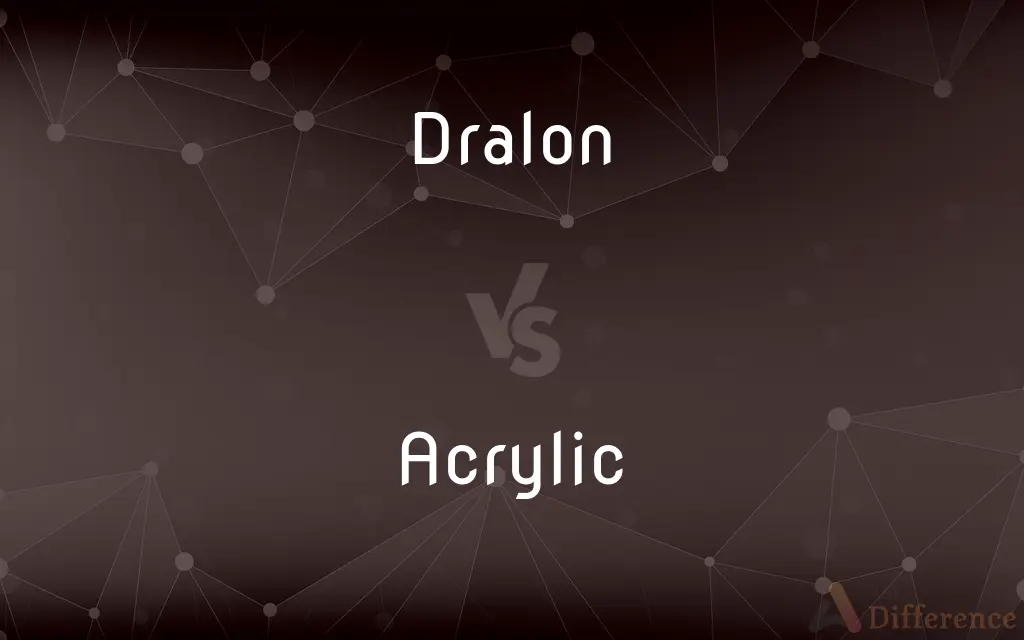Dralon vs. Acrylic — What's the Difference?
By Maham Liaqat & Urooj Arif — Updated on March 27, 2024
Dralon is a brand of acrylic fiber known for its durability and resistance to weathering, while acrylic, a synthetic polymer, is widely used in textiles for its warmth and lightweight properties.

Difference Between Dralon and Acrylic
Table of Contents
ADVERTISEMENT
Key Differences
Dralon, as a specific brand of acrylic fiber, is engineered for enhanced performance characteristics, such as improved durability and resistance to sunlight and chemicals. Acrylic, in its general form, serves as the base material from which Dralon is made, offering a wide range of applications due to its versatility and warmth.
Acrylic fibers are celebrated for their ability to mimic wool, providing warmth without the heaviness or itchiness, making them ideal for sweaters and blankets. Dralon takes these qualities further by offering additional benefits like colorfastness and low moisture absorbency, making it suitable for outdoor furniture and textiles.
The manufacturing process of Dralon involves specialized treatments to enhance its performance, especially for use in environments where exposure to the elements is a concern. On the other hand, generic acrylic fibers may not undergo these specific treatments, thus differing in their suitability for certain applications.
In terms of environmental considerations, both Dralon and acrylic face challenges related to synthetic fibers, such as microplastic pollution. However, there are ongoing efforts within the industry to address these issues, such as recycling programs and developing more sustainable production methods.
Dralon's unique characteristics make it particularly popular in the manufacturing of awnings, outdoor furniture, and sports clothing, where its enhanced properties can be fully utilized. In contrast, acrylic's general application includes a broader spectrum of products, from clothing and blankets to paint and aquariums, showcasing its versatility.
ADVERTISEMENT
Comparison Chart
Type
Brand of acrylic fiber
Synthetic polymer fiber
Key Features
Durability, resistance to sunlight and chemicals
Warmth, lightweight, wool-like texture
Applications
Outdoor furniture, awnings, sports clothing
Sweaters, blankets, a wide range of textile products
Manufacturing
Specialized treatments for enhanced performance
Standardized production for versatility
Environmental
Challenges similar to acrylic but with initiatives for sustainability
Microplastic pollution, with efforts towards recycling
Suitability
Suited for outdoor and high-performance needs
Suited for general textile needs and a variety of other applications
Innovation Focus
Performance and durability in challenging conditions
Versatility and comfort in everyday use
Compare with Definitions
Dralon
A high-performance brand of acrylic fiber.
The outdoor cushions are made from Dralon for enhanced durability.
Acrylic
Lightweight and warm, suitable for clothing.
Acrylic sweaters are popular for their wool-like feel without the itch.
Dralon
Known for its weather-resistant properties.
Dralon awnings remain vibrant and resistant even after years of sunlight exposure.
Acrylic
Versatile in applications beyond textiles, such as in paints.
Acrylic paints are favored for their quick drying time and durability.
Dralon
Utilized in sports clothing for its moisture-wicking abilities.
The team's jerseys are crafted from Dralon to keep players dry and comfortable.
Acrylic
Challenges include environmental impact, like microplastic pollution.
Companies are exploring recycling methods to reduce acrylic's environmental footprint.
Dralon
Offers low moisture absorbency, ideal for outdoor textiles.
Poolside loungers use Dralon fabric to prevent water damage and mildew.
Acrylic
A synthetic polymer fiber used widely in textiles.
The soft, warm blanket is made of acrylic, mimicking wool.
Dralon
Favoured for its resistance to chemicals and sunlight.
Industrial workwear made from Dralon withstands harsh chemicals and prolonged outdoor use.
Acrylic
Can be produced to mimic various natural fibers.
Acrylic fibers are spun into yarns that closely resemble cotton and wool.
Dralon
(UK) A fiber made of acrylic.
Acrylic
(of synthetic resins and textile fibres) made from polymers of acrylic acid or acrylates
A red acrylic jumper
Dralon
(UK) Fabric made from dralon.
Acrylic
An acrylic textile fibre
A sweater in four-ply acrylic
Acrylic
An acrylic paint
Washes of white acrylic
She paints mainly in acrylics
Acrylic
An acrylic resin.
Acrylic
A paint containing acrylic resin.
Acrylic
A painting done in acrylic resin.
Acrylic
Any of numerous synthetic fibers polymerized from acrylonitrile.
Acrylic
(organic chemistry) Derived from acrylic acid or acrylonitrile.
Acrylic
Containing an acrylic resin.
Acrylic
(organic chemistry) An acrylic resin.
Acrylic
(painting) A paint containing an acrylic resin.
When it comes to painting, I prefer using acrylics as my medium.
Acrylic
A painting executed using such a paint.
Acrylic
A thick sheet of plastic.
Acrylic
A liquid coating system based on an acrylic resin.
Acrylic
Of or containing acryl, the hypothetical radical of which acrolein is the hydride; as, acrylic acid. The characteristic residue in an acrylic compound is the carbonyl group attached directly to an ethylenic carbon.
Acrylic
Same as acrylic resin.
Acrylic
Same as acrylic fiber.
Acrylic
A paint in which the pigment is suspended in a solution of an acrylic resin, which dries to a hard film on exposure to air.
Acrylic
A painting made using an acrylic paint.
Acrylic
Polymerized from acrylonitrile
Acrylic
A glassy thermoplastic; can be cast and molded or used in coatings and adhesives
Acrylic
Used especially by artists
Acrylic
A synthetic fabric
Common Curiosities
What is Dralon?
Dralon is a specific brand of acrylic fiber known for its enhanced performance characteristics, including durability and resistance to environmental factors.
What makes Dralon suitable for outdoor furniture?
Dralon's low moisture absorbency, resistance to sunlight, and durability make it ideal for outdoor furniture, offering longevity and maintaining appearance over time.
Can both Dralon and acrylic be used for clothing?
Yes, both can be used for clothing, but Dralon is often chosen for outdoor or performance wear due to its specific properties, while acrylic is widely used for a variety of garments, including sweaters and accessories.
What is acrylic?
Acrylic is a synthetic polymer fiber used extensively in textiles and other applications for its warmth, lightweight, and versatility.
Are there environmental concerns associated with Dralon and acrylic?
Both face environmental challenges, primarily related to microplastic pollution, but efforts are underway to mitigate these impacts through recycling and sustainable production practices.
How do Dralon and acrylic differ?
Dralon is a brand of acrylic that offers specialized properties like enhanced durability and resistance, whereas acrylic refers to the broader category of synthetic fibers with a wide range of applications.
Is Dralon more durable than regular acrylic?
Yes, Dralon is engineered for enhanced durability, especially in applications where resistance to sunlight, chemicals, and wear is important.
What are the key advantages of Dralon over traditional acrylic fibers?
Dralon's key advantages include superior durability, weather resistance, and specialized properties for high-performance and outdoor applications, setting it apart from traditional acrylic fibers.
Why is acrylic favored in textile production?
Acrylic is favored for its ability to mimic natural fibers like wool, providing warmth and comfort without the weight or itchiness, alongside its versatility in a wide range of textile products.
Can acrylic fibers be recycled?
Yes, acrylic fibers can be recycled, and there are initiatives aimed at increasing the recycling rates for these and other synthetic fibers to reduce their environmental footprint.
Share Your Discovery

Previous Comparison
Predicative vs. Attributive
Next Comparison
Abhor vs. HateAuthor Spotlight
Written by
Maham LiaqatCo-written by
Urooj ArifUrooj is a skilled content writer at Ask Difference, known for her exceptional ability to simplify complex topics into engaging and informative content. With a passion for research and a flair for clear, concise writing, she consistently delivers articles that resonate with our diverse audience.














































